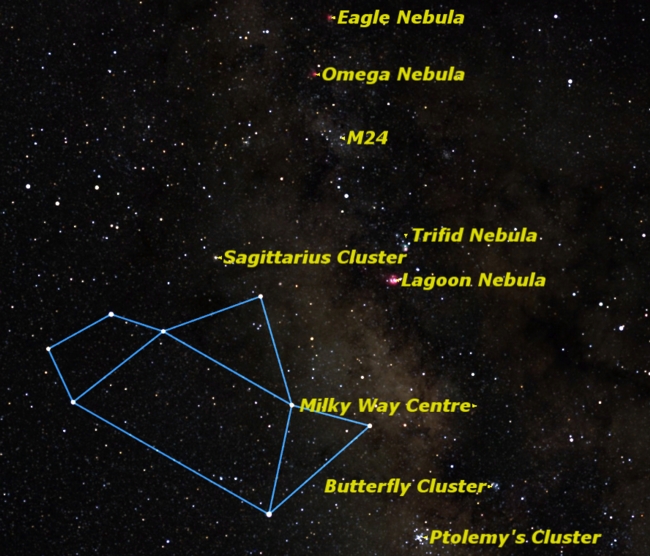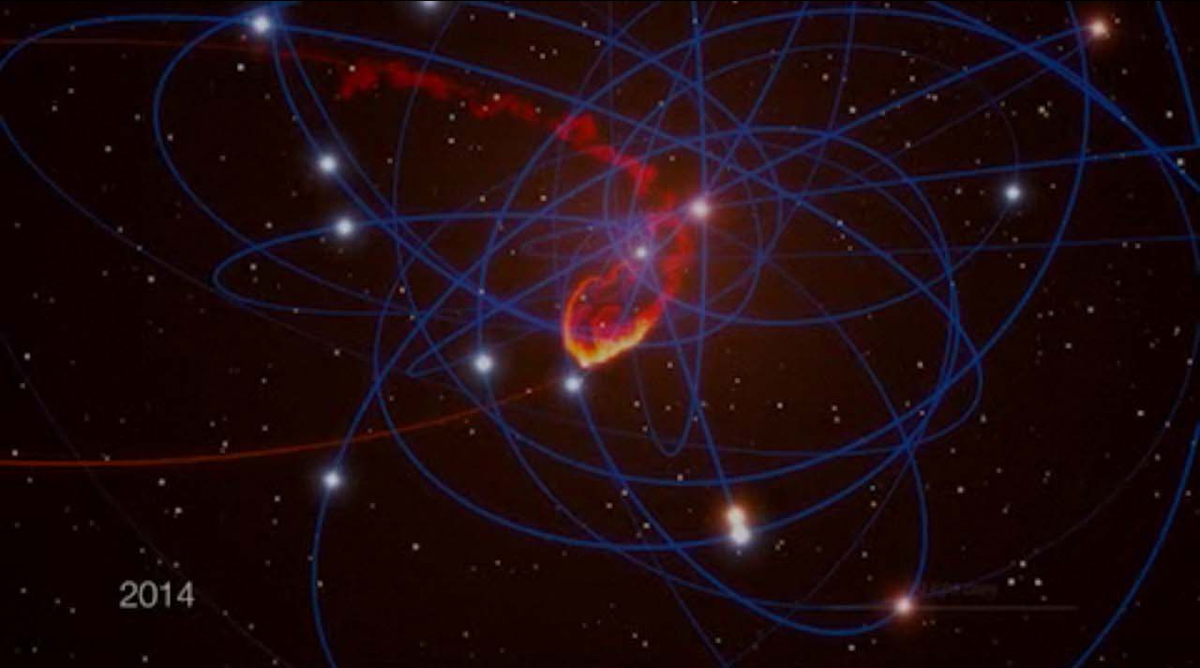Sagittarius Constellation: Facts About the Archer

Occupying 867 square degrees, Sagittarius is the largest constellation in the Southern Hemisphere and the 15th largest constellation overall. The constellation has many bright stars and is very visible with the naked eye.
As is the case with all of the Zodiac constellations, Sagittarius was recorded in the 2nd century by the Greek astronomer Ptolemy, and it is Latin for archer.
Locating Sagittarius
Sagittarius is at the center of the Milky Way Galaxy, and the galaxy is at its densest point as it makes its way through Sagittarius.
In addition to Capricornus and Scorpius, the constellation borders Aquila, Scutum, Serpens Cauda, Ophiuchus, Corona Australis, Telescopium, Indus and Microscopium.
- Right ascension: 19.11 hours
- Declination: -25.8 degrees.
- Visible: between 55 degrees and -90 degree
- Best viewed: August around 9 p.m.
NASA's Hubble Space Telescope recently captured a detailed view of the brightest stars in the constellation.

Notable stars and objects
The constellation's brightest stars — Delta, Epsilon, Zeta, Phi, Lambda, Gamma-2, Sigma and Tau Sagittarii — form a star pattern, or asterism, called the Teapot. Delta, Epsilon and Lambda Sagittarii come together to form the archer's bow.
While typical naming conventions have the alpha star as the brightest star in a constellation, German celestial cartographer Johann Bayer did not follow his own rule. Instead, he named the brightest star Epsilon Sagittarii (Kaus Media, or middle bow). The 36th brightest star in the sky, Epsilon Sagittarii is 145 light-years distant and 375 times brighter than the sun, though slightly smaller. According to astronomer David Darling, Epsilon Sagittarii has traditionally been classified as a cool B-star, but more recent observations have classified it as a hot-end class A as a bright giant.
"In any event," Darling says on his website, "the star is much brighter than its main sequence counterparts and is clearly in a more advanced state."
Forming the top of the Teapot, Lambda Sagittarii (Kaus Borealis, or northern bow) is 77 light-years from the sun and is the fifth-brightest star (though Lambda is the eleventh letter in the Greek alphabet). An orange giant, the star is 11 times brighter than the sun and lies about 77 light-years away.
"With a mass about 2.3 times solar, Kaus Borealis is a prime example of what astronomers call a 'clump star,' one that, though dying, is currently quite stable," Jim Kaler, astronomer and professor emeritus at the University of Illinois, said on his website.
Delta Sagittarii (Kaus Media, or middlebow) is a double star about 350 light-years from the sun. The giant star has three dim companions that may or may not be connected to the primary. In 2016, a working group organized by the International Astronomical Union approved the name Kaus Media for the star.
At the tip of the arrowhead lies a pair of double stars that share the Gamma Sagittarii designation. Instead of a single star, W Sagittarii (Gamma-1) is made up of three components, with the primary star a pulsing yellow supergiant six times as massive as the sun. W Sagittarii lies approximately 95 light-years from Earth. An orange giant, 10 Sagittarii (Gamma-2) lies more than 400 light-years from Earth. The IAU's working group approved the name Alnasi for the star.
With a magnitude of 2.1, Sigma Sagittarii this is the second brightest star in Sagittarius.
Making up the armpit, Zeta Sagittarii, also known as Ascella, is the third brightest star in the constellation. It is a double star about 90 light-years distant.
Sagittarius is home to the bright blue hypergiant Pistol Star, one of the brightest stars discovered in the Milky Way. While it is bright, it is barely visible to the naked eye due to a great deal of interstellar dust that surrounds it. It is part of a dense region full of massive young stars known as Quintuplet Cluster near the center of the galaxy, roughly 25,000 light-years from the sun.
When NASA's Hubble Space Telescope examined the star in 1997, it was thought to be the most luminous star ever known. Later observations scaled down its brightness somewhat. Still, the star may hold records on its formation size.
"At the time of its formation about 2 million years ago, the Pistol Star may have been one of the most massive stars in the Milky Way," Christophe Martayan wrote in his research on the star.
Sagittarius lies in a region of the sky that points to the center of the Milky Way. Within the constellation lies a bright radio source known as Sagittarius A* (pronounced "Sagittarius A-star" and abbreviated Sgr A*), a supermassive black hole in the heart of the galaxy. While astronomers cannot observe a black hole directly, they can observe how it affects the stars around it.
"The Galactic Center harbors the closest supermassive black hole known," said Stefan Gillessen in a press release. "Hence, it is the best place to study black holes in detail."
That region of space also contains several nebulae, including the Lagoon Nebula (M8 or NGC 6523), a large interstellar cloud about 50 by 110 light-years in dimension. The Omega Nebula (M17 or NGC 6618) and the Trifid Nebula (M20 or NGC 6514) are star nurseries birthing dozens of new stars.
The Sagittarius Dwarf Elliptical Galaxy was the first globular cluster ever discovered outside the Milky Way. [Related: Hubble Photographs Dozens of Colliding Galaxies]

Myth of Sagittarius
In astrology, which is not a science, Sagittarius is the ninth sign in the Zodiac and represents those born between Nov. 22 and Dec. 21.
The Greeks identify Sagittarius as a centaur, horse-human hybrid with the body of a man atop the four legs of a horse. The creature is aiming an arrow toward its neighbor Scorpio. The lore has Sagittarius the Archer shooting Scorpio the Scorpion, which had been sent to kill Orion the Hunter.
Sagittarius is sometimes confused with another centaur, Chiron of the Centaurus constellation.
The Babylonians associated Sagittarius with the god Pabilsaĝ, who had two heads (one human, one panther), wings and was sometimes called "the wild bull with multicolored legs."
Additional reporting by Nola Taylor Redd, Space.com Contributor.
Join our Space Forums to keep talking space on the latest missions, night sky and more! And if you have a news tip, correction or comment, let us know at: community@space.com.
Breaking space news, the latest updates on rocket launches, skywatching events and more!
Kim Ann Zimmermann is a contributor to Space.com and sister site Live Science, writing mainly evergreen reference articles that provide background on myriad scientific topics, like the constellations, astronauts, climate, culture and medicine. Her work can also be found at Business News Daily and KM World. She holds a bachelor’s degree in communications from Glassboro State College.
